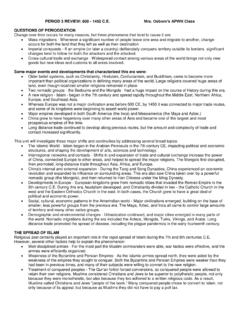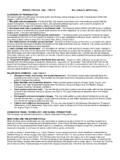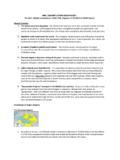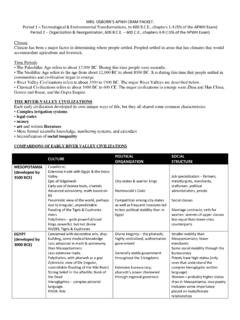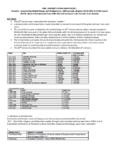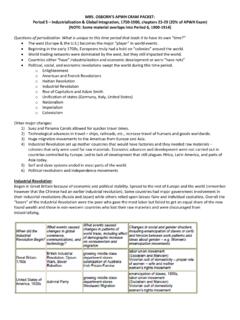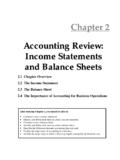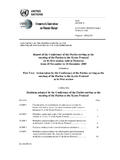Transcription of PERIODS 1/2 REVIEW (8000 BCE TO 600 CE) Mrs. …
1 PERIODS 1/2 REVIEW ( 8000 bce to 600 CE) Mrs. Osborn s APWH Class ENVIRONMENTAL AND PERIODIZATION ISSUES The ability to settle was based almost entirely on successful cultivation of crops and domestication of animals. These drastic changes in human life are known collectively as the Neolithic Revolution that almost certainly happened independently in different places over a large span of time. Although the Neolithic Revolution was one of the most significant Marker Events in world history, it occurred gradually and probably by trial and error. The changes that resulted include: Increase in reliable food supplies - Agricultural skills allowed people to control food production, and domestication of animals both helped to make agricultural production more efficient and increased the availability of food.
2 Rapid increase in total human population - Reliable food supplies meant that people were less likely to starve to death. With increasing life spans came increasing reproduction, and more children meant that there were more people to tend the land and animals. Job specialization - Other occupations than farming developed, since fewer people were needed to produce food. Some early specialized jobs include priests, traders, and builders. Widening of gender differences - Status distinctions between men and women increased, as men took over most agricultural cultivation and domestication of animals. Women were responsible for raising children, cooking food, and keeping the house, but in virtually all of the early civilizations men became more and more dominant.
3 A patriarchal system commonly developed, with men holding power in the family, the economy, and the government. Development of distinction between settled people and "nomads" - All people did not settle into communities but remained as hunters and gatherers. As more settled communities developed, the distinction between agriculturalists and hunters and gatherers grew. THE NATURE OF CIVILIZATION These changes in turn allowed the development of "civilization," a basic organizing principle in world history. Civilization may be defined in many ways, but it is generally characterized by: Large cities that dominate the countryside around them - Growing populations required more food production, so the cities controlled their hinterlands in order to guarantee a reliable and continuous supply of food for their inhabitants.
4 Monumental architecture and public building projects that take many forms - They may include temples, palaces, irrigation projects, city walls, public arenas, government buildings, and aqueducts. A complex political organization - In order to coordinate activities and provide protection for the cities and hinterlands, governments developed. The larger the area and population, the more demanding political positions became, and control of the government began to move away from kinship ties. Although many early rulers passed their authority down to their sons, other factors became important, such as military prowess and ability. A written language - This important development in human history allowed societies to organize and maintain the growing political, social, and economic structure that followed settlement into agricultural areas.
5 Those societies that developed a written language were able to communicate multiple ideas and large amounts of information that in turn encouraged greater complexity and growth. Specialization of labor - With basic food needs taken care of by fewer people, others may specialize in jobs that help to improve the quality of life. For example, engineers may construct bigger and better irrigation systems, and bureaucrats may increase their level of government services. Advanced art and literature - In prehistoric times and in simple communities, most artwork and literature was (is) produced by people who were preoccupied with activities that sustained their lives, such as hunting and gathering or farming. Art consisted of simple drawings, and literature usually took the form of oral stories passed down from one generation to the next.
6 With the advent of civilization, some people had the time to concentrate on art and literature, making them their primary occupation. Long distance trade - As technologies improved and specialization increased, trade with other civilization centers began. This trade led to cultural diffusion, or the spreading and sharing of cultural characteristics. Not only was material culture - objects such as pottery, tools, and textiles - shared, but nonmaterial culture - such as beliefs, customs, and values - also spread, contributing to the cosmopolitan nature of cities. THE CIVILIZATION CONTROVERSY Advantages of Civilization Disadvantages of Civilizations Development of specialized skills, inventions, arts, and literature Increase in class and gender distinctions, creating oppression for some Building of economically and politically coordinated cities Overproduction of land, depletion of soil, eventual destruction caused by increase in population Increased ability to protect people from dangers both inside and outside the city Increased attacks from outsiders attracted to wealth.
7 Internal crime promoted by crowded conditions Growth of prosperity, improving quality of life Creation of life-threatening congestion, pollution, disease, and decrease in sanitation PERIODIZATION The Foundations time period ( 8000 bce to 600 CE) is so vast that there are many ways to divide it into PERIODS or eras. However, some major breaks within the time period are these: 1) Early agricultural and technological development (about 8000 BCE to 3500 BCE) - Small groups of settlers grew into kinship-based villages that practiced both crop cultivation and domestication of animals. Tools and inventions helped villages to stabilize and eventually grow. 2) Development of the earliest civilizations (about 3500 to 1500 BCE) - Villages grew into cities that came to dominate the land around them.
8 Collectively known as the "river valley" civilizations, they include: Mesopotamia (developed by 3500 BCE or so) - between the Tigris and Euphrates Rivers in the Middle East Egypt (developed by 3000 BCE or so) - along the Nile River in northeastern Africa Indus Valley people (developed by 2500 BCE or so) - along the Indus River in south central Asia Shang China (developed by 1700 BCE or so) - along several rivers in the north China plains 3) Classical civilizations (approximately 1000 BCE to 600 CE) - These civilizations were generally much larger than the earlier ones, and their political economic, cultural, and military organizations usually were more complex. All traded extensively with others, and conquered many new territories. Classical civilizations include Zhou and Han China, the Roman Empire, and the Gupta Empire in India.
9 COMMON CHARACTERISTICS OF THE RIVER-VALLEY CIVILIZATIONS Each early civilization developed its own unique ways of life, but they all shared some common characteristics: Location in river valleys - Rivers provided water for crops, as well as the easiest form of transportation. All four river valleys of the earliest civilizations had very fertile soil called loess, or alluvial soil carried and deposited as river water traveled downstream. Complex irrigation systems - Controlling the flow of the rivers was a major issue for all of the civilizations, and all of them channeled the water for agricultural use through irrigation systems. Development of legal codes - The most famous set of laws was Hammurabi's Code, but all wrote and implemented laws as political organization and long-distance trade grew more complex.
10 Use of money - Long distance trade made the barter system (trading one type of good for another) impractical, so all the civilizations developed some form of money for economic exchanges. Elaborate art forms and/or written literature - These took different forms, but all civilizations showed advancements in these areas. For example, Egyptians built pyramids and concentrated on decorate arts, and Mesopotamians wrote complex stories like the Epic of Gilgamesh. More formal scientific knowledge, numbering systems, and calendars - Developments in these areas varied from civilization to civilization, but all formalized knowledge in at least some of these areas. Intensification of social inequality - In all river valley civilizations, gender inequality grew, and all practiced some form of slavery.
